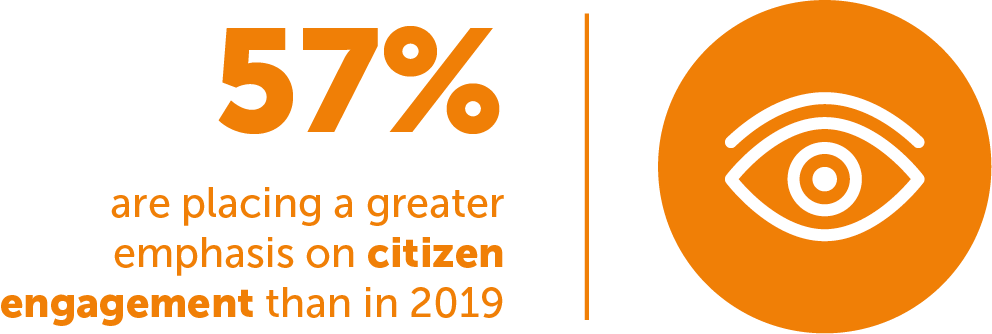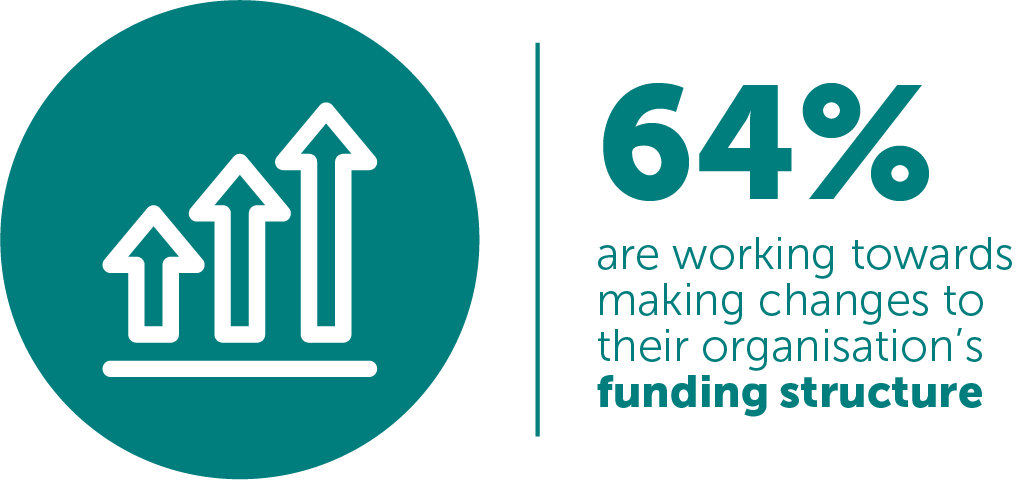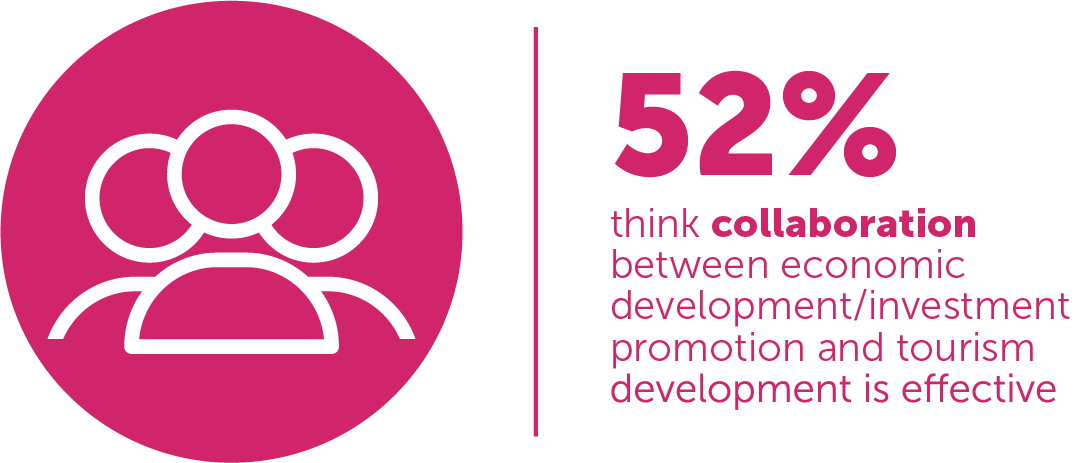Four findings from the 2021 place branding survey
Thankfully, the process for this year’s City Nation Place survey has been substantially less dramatic than last year – when the COVID pandemic hit immediately after we’d gathered our responses, and we had to re-run questions to see how priorities were being impacted in the short term by the crisis. Whilst the impact of the pandemic is ongoing, the 2021 Survey has been able to look back on the past year and forward to the next, to explore the longer-term changes this is bringing to the practice of place branding and marketing for cities, regions, and nations around the world.
While the report of our findings is available now, there are a few key issues that places were grappling with that we’d like to highlight and explore…
FINDING 1: 57% are placing a greater emphasis on citizen engagement
We asked our respondents how much of their time is currently focussed on their citizens – and whether or not that was a greater or lesser focus than in 2019. The majority of respondents admitted that they had indeed increased their focus on their citizens, with only a very small number saying that they had decreased their domestic focus over the year.
This in-line with what we’ve been seeing from around the world, with domestic visitors and existing investors taking on new importance for many places as borders shut. However, there was a lot of variance in what people considered to be the ‘most’ and ‘least’ important priority in citizen engagement at this time.
If you’re looking for more information on how you can evolve your citizen engagement strategy, we’ve collated some key resources below to help inspire your approach:

- We shared some of the earliest ways in which DMOs and EDOs moved beyond marketing to support their citizens and local businesses during the early days of the virus.
- Dan Holowack, co-founder and CEO of Crowdriff, shares fantastic advice for places looking to encourage their locals to be their storytellers
- Throughout the pandemic, there’s been an upswell of community goodwill. How can places work more effectively with their community businesses as we rebuild?
- Lithuania’s nation brand has been built upon a firm foundation of citizen engagement. Their 2019 winning case study, Lithuania’s DNA, shows how they uncovered existing domestic perceptions to build their nation brand, while Olga Gončarova, Head of Domestic & Inbound Tourism for Lithuania Travel, outlined how this focus has evolved as they encouraged Lithuanians to experience Lithuania from home.
FINDING 2: 45% will increase their focus on sustainability
Sustainability is an interesting challenges for places, and it was clear from our respondents that we need to be more intelligent with what we mean by ‘sustainability’ in our places. Whilst achieving a positive environmental impact – and avoiding a negative one – were incorporated into the definition of ‘sustainable’ for many of our respondents, the most-voted-for elements focussed on ensuring that each visitor and each investment delivers long-term value for the community.
As we rebuild in the wake of COVID-19, there is an opportunity for all of us to think about our long-term strategies and how they deliver value for our communities. Encouragingly, 45% of our respondents are intending to increase their focus on sustainability in the coming years, and a similar number are planning to at least maintain their current focus.
So who can we learn from as we look to evolve our understanding of sustainable place branding? Below are a list of articles and case studies which outline different ways place have been approaching the challenge…

- We created a roadmap for sustainable recovery to help inspire places looking to create a more sustainable strategy as they recovery from COVID-19.
- How can you position sustainability at the heart of your place brand strategy? Laura Aalto, CEO at Helsinki Marketing, and Daniel Valverde, Country Brand Director for Costa Rica, share the city and country perspective of using global values as core drivers for your place identity.
- Winner of the 2020 Place Brand of the Year award, Nick Hill, CEO of ATEED (Auckland Tourism, Events, and Economic Development), outlined how the city is putting the spotlight on sustainable destination management and Māori values.
- Visit Faroe Islands inspired the world in 2019 when they ‘closed for the weekend.’ Instead, they encouraged ‘voluntourists’ to come to the island to help locals repair the damage done around the island from the increase in tourism.
FINDING 3: 64% are now working to make changes to their funding structures
COVID-19 has accelerated a trend that we were already beginning to see. While many place brand organisations were beginning to understand the vulnerability of relying on a sole source of funding, the challenges of 2020 have highlighted just how precarious the situations can be.
Given the stability that many of our public sector-funded respondents seem to have enjoyed during the pandemic, it may seem counter-intuitive that these organisations are looking to increase private sector contributions, but as place governments count the cost of boosting economic recovery, private-sector funding may seem less vulnerable to political change. And diversifying funding streams will help to increase resiliency to future crises – whether to the public or private sector.
Over the years, we’ve been fortunate to hear from a number of places who have been particularly innovative with their funding strategies. Perhaps your future funding model might be one of these…

- Melissa Baird from the Global Destination Sustainability Movement, shared insights from their latest research on how places are leveraging tourism taxation to fund a more regenerative future.
- Our expert partners shared six tips to help place brand and marketing organisations be more cost effective and to maximise the return on every dollar’s investment.
- This one is pre-pandemic, but there’s still a number of interesting lessons to be learned. Colin Ferguson, President & CEO of Travel Manitoba, Peter Kentie, Managing Director of Eindhoven365, and Ray Hoyt, President of Visit Tulsa, joined us at the 2019 Global conference to explore innovative approaches to funding and stakeholder engagement.
FINDING 4: 52% think their collaboration between their economic development and tourism teams is effective
Just over half of our respondents felt that the collaboration between their economic development and tourism teams is effective or very effective. However, that means there are still 48% who felt that there is improvement that can be made in this area.
Collaboration between different teams is at the core of successful place branding; if you’re promoting a singular identity, it ensures that every single marketing communication helps cement your place identity. Getting political leadership to highlight the connection between these organisations could be the key to success though. As one respondent commented, “Selling a city for all of these audiences and opportunities should apply common narratives and language, and needs to be heard from the political leaders, as well as the leaders in these [teams].”
We’ve collected some of the top examples of collaboration between internal teams to spark some ideas for your own strategies –there’s also some ideas on how places can work together to achieve a common goal!

- Mary Harris, Managing Director at M&C Saatchi Export, discussed different ways that teams, places, and governments can collaborate together in order to accelerate FDI and stand out from the crowd.
- The Utrecht Region is located in the hear of the Netherlands. The region knew they needed to create a strong unified identity to attract talent, visitors, and investment from more well-known location. Find out more about how they launched a collaborative design identity for the region.
- On the talent attraction side, Alison Treaster of Allegheny Conference on Community Development, explored how a firm collaborative partnership with key private sector has created an ingenious internship programme and delivered benefits to all involved.
- And finally, discover how London and Paris launched a collaborative marketing partnership and joined forces to reach an audience of US millennials instead of competing against each other.
Hopefully there’s something there for everyone – but when you’re ready to dive even deeper, make sure to download our survey report for the full findings!









